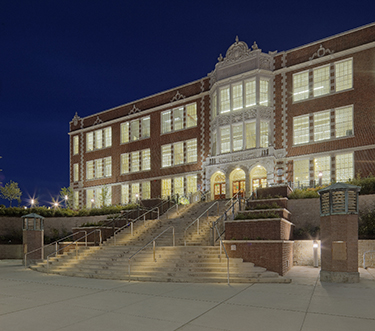|
Subscribe / Renew |
|
|
Contact Us |
|
| ► Subscribe to our Free Weekly Newsletter | |
| home | Welcome, sign in or click here to subscribe. | login |
Construction
| |
 |
August 25, 2016
When does renovating a school mean bringing it ‘up to code’?
PCS Structural Solutions

Stauffer
|

Maddox
|
When undertaking the renovation of an existing educational facility, there are numerous questions that must be asked and answered.
This is the case for all of the major systems that make up the building: roofing and siding, mechanical and electrical systems, and, of course, the building structure. While it’s often apparent that upgrades to these systems are needed, determining the scope of work necessary to achieve desired, or often mandated, seismic upgrades often takes a thorough investigation.
Depending on the age of the building, some systems may require more attention than others. For example, many buildings constructed in the past 20 years will not require significant structural improvements, except in response to reconfiguration of program spaces. This is due to the fact that modern building codes are much more comprehensive than older codes in accounting for the effects of earthquakes on buildings.
When older building codes were developed, the dynamic nature of seismic loading and its effect on structural systems was far less understood. As such, the magnitude of loads that could be generated by seismic events was typically underestimated. This is especially true in the Pacific Northwest, where susceptibility to large earthquakes was largely unknown until relatively recently.
In addition, older methods of construction lacked the durability and resiliency required of buildings constructed under current building codes.
A good example of this is in unreinforced masonry buildings. These structures accounted for the vast majority of the damage experienced in the Puget Sound region during the Nisqually earthquake in 2001. This damage was due to the brittle nature of the materials used in masonry wall construction.
Evaluating the structure
Addressing these deficiencies and those of other types of structural systems becomes the primary focus of the structural engineer during the early planning stages of any planned building renovation.
Generally, this process begins with an evaluation of the existing structure, which focuses on identifying the weak spots in the vertical and lateral load carrying systems. Assuming that the building has been functioning prior to the renovations, it is unlikely that this investigation will find significant deficiencies in the vertical load system. The lateral load resisting system then becomes the primary focus of these evaluations.
There are several tools that can be used to facilitate the structural evaluation, including standards developed by the Federal Emergency Management Agency and the American Society of Civil Engineers (ASCE).
These standards are generally geared toward identifying portions of a building that have been problematic in similar buildings during past earthquakes. Once these deficiencies are identified, a plan of attack can be developed for improvements to the structure.
At this point in the process, it is generally prudent to begin dialogue with the local building department to establish what will be required as part of the planned renovations. Smaller-scale renovations can often be done without triggering seismic improvements, whereas more significant modifications will generally mandate upgrades that bring the building into compliance with the intent of current building code standards.
This often becomes a source of negotiation between the building official, the structural engineer, and the architect or building owner. During these negotiations, the idea of bringing the building “up to code” is weighed against those portions of the structure that will remain in place, but cannot be modified to be in strict compliance with building code provisions. Oftentimes, individual structural components that are not in compliance with code provisions can be supplemented with redundant structural elements that will maintain stability in a building that has experienced significant structural damage.
Again, unreinforced masonry buildings provide a good example of this scenario: New beams and columns can be provided adjacent to bearing walls to provide vertical support of floor and roof framing in the event that the walls are damaged to the extent of losing capacity.
These types of measures will help to significantly improve building occupants’ safety during a seismic event, and will allow for safe exiting of a building after an event.
Choosing the scope
For these types of situations, there is a separate set of code provisions geared specifically toward strengthening existing buildings.
The International Building Code (IBC) references two separate documents of this type. The first is the International Existing Building Code, which is published by the same group that is responsible for the IBC. The second is the ASCE 41 document, which is a standard that has been developed over the past few decades to address the needs for both evaluation and renovation of existing structures.
Both of these documents provide guidance for both the building official and engineer in determining the scope of improvements that will be needed to bring the building up to code.
Once the structural scope is defined, along with the scope of the other design disciplines, cost estimates are made to determine the costs of the anticipated renovation work. These costs are weighed carefully with various other considerations to determine the feasibility of renovations versus replacement with new construction.
Some considerations include the ease or difficulty of fitting new educational programming into an existing building shell, how and where new mechanical and electrical systems will be incorporated, and whether the building has historical significance to the community. Additionally, sustainability goals are evaluated, with the understanding that retaining an older building and breathing new life into it is in itself an act of sustainability.
Planning the execution of renovations and deciding whether there will be a need for phased construction or if the entire facility can be made available for renovation work is also a critical piece of the puzzle in determining if the building can be feasibly renovated.
Once the details of the questions outlined above begin to fall into place, the designs for the renovated building can begin in earnest with an eye to the goal of providing future generations with a modern learning environment while retaining and refreshing an aged community asset.
Craig Stauffer is the managing principal of the Seattle office of PCS Structural Solutions, and Bret Maddox is an associate principal in the Tacoma office. PCS Structural Solutions is a single-discipline structural engineering firm based in Tacoma and Seattle.
Other Stories:
- New Mount Si High will sit atop 4,800 stone columns
- How to design a school restroom that works for everyone
- School projects in remote Alaskan villages face tall hurdles
- Lynden Elementary: from concept to completion in 22 months flat
- Learning center in Tacoma Park will serve students and the community
- Clark College creating a regional hub for STEM
- ‘Dark,’ ‘maze-like’ student union gets a big makeover
- Tahoma School District responds quickly to surging enrollment



